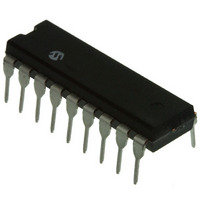PIC16HV540-20/P Microchip Technology, PIC16HV540-20/P Datasheet - Page 5

PIC16HV540-20/P
Manufacturer Part Number
PIC16HV540-20/P
Description
IC MCU OTP 512X12 18DIP
Manufacturer
Microchip Technology
Series
PIC® 16Cr
Datasheets
1.PIC16HV540-04IP.pdf
(85 pages)
2.PIC16HV540-04IP.pdf
(6 pages)
3.PIC16HV540-04IP.pdf
(12 pages)
Specifications of PIC16HV540-20/P
Core Processor
PIC
Core Size
8-Bit
Speed
20MHz
Peripherals
Brown-out Detect/Reset, POR, WDT
Number Of I /o
12
Program Memory Size
768B (512 x 12)
Program Memory Type
OTP
Ram Size
25 x 8
Voltage - Supply (vcc/vdd)
3.5 V ~ 15 V
Oscillator Type
External
Operating Temperature
0°C ~ 70°C
Package / Case
18-DIP (0.300", 7.62mm)
Processor Series
PIC16H
Core
PIC
Data Bus Width
8 bit
Data Ram Size
25 B
Maximum Clock Frequency
20 MHz
Number Of Programmable I/os
12
Number Of Timers
8
Operating Supply Voltage
3.5 V to 15 V
Maximum Operating Temperature
+ 70 C
Mounting Style
Through Hole
Minimum Operating Temperature
0 C
Lead Free Status / RoHS Status
Lead free / RoHS Compliant
Eeprom Size
-
Data Converters
-
Connectivity
-
Lead Free Status / Rohs Status
Details
Available stocks
Company
Part Number
Manufacturer
Quantity
Price
Company:
Part Number:
PIC16HV540-20/P
Manufacturer:
Microchip Technology
Quantity:
135
FIGURE 1-2:
1.6
The ID Locations area is only enabled if the device is in
a test or programming/verify mode. Thus, in normal
operation mode only the memory location 0x000 to
0xNNN will be accessed and the Program Counter will
just roll over from address 0xNNN to 0x000 when incre-
mented.
The configuration word can only be accessed immedi-
ately after MCLR going from V
Counter will be set to all ’1’s upon MCLR = V
it has the value “0x7FF” when accessing the configura-
tion EPROM. Incrementing the Program Counter once
by pulsing OSC1 causes the Program Counter to roll
over to all '0's. Incrementing the Program Counter 4K
times after reset (MCLR = V
the configuration EPROM.
1.6.1
Per definition, the first four words (address TTT to TTT
+ 3) are reserved for customer use. It is recommended
that the customer use only the four lower order bits (bits
0 through 3) of each word and filling the eight higher
order bits with '0's.
A user may want to store an identification code (ID) in
the ID locations and still be able to read this code after
the code protection bit was programmed. This is pos-
sible if the ID code is only four bits long per memory
location, is located in the least significant nibble bound-
ary of the 12-bit word, and the remaining eight bits are
all '0's.
1999 Microchip Technology Inc.
NNN Highest normal EPROM memory address. NNN = 0x1FF for PIC16HV540.
TTT
Special Memory Locations
CUSTOMER ID CODE LOCATIONS
Start address of special EPROM area and ID Locations.
PIC16HV54X SERIES PROGRAM MEMORY MAP IN PROGRAM/VERIFY MODE
Address
(Hex) 000
NNN
TTT
TTT + 1
TTT + 2
TTT + 3
TTT + 3F
(FFF)
IL
) does not allow access to
IL
to V
11
User Program Memory
HH
(NNN + 1) x 12 bit
0
0
0
0
. The Program
Bit Number
IL
0
0
0
0
. Thus,
ID0
ID1
ID2
ID3
0
EXAMPLE 1:
The Customer ID code “0xD1E2” should be stored in
the ID locations 200-203 like this:
Reading these four memory locations, even with the
code protection bit programmed would still output on
Port A the bit sequence “1101”, “0001”, “1110”, “0010”
which is “0xD1E2”.
Note:
200:
201:
202:
203:
For Customer Use
(4 x 4 bit usable)
For Factory Use
Configuration Word 4 bit
Microchip will assign a unique pattern
number for QTP and SQTP requests and
for ROM devices. This pattern number will
be unique and traceable to the submitted
code.
0000 0000 1101
0000 0000 0001
0000 0000 1110
0000 0000 0010
CUSTOMER CODE 0xD1E2
PIC16HV54X
DS30467A-page 5












